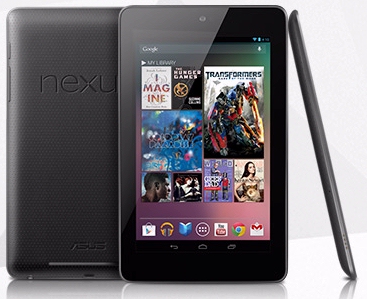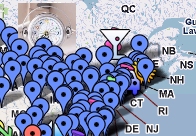
Google just announced a new tablet-sized device to compete with the Kindle Fire tablet. Google will release it in about a week, but it’s already getting some great reviews. Amazon had enjoyed one big advantage when competing with Apple’s iPad: their Kindle Fire tablet only cost $199. But Thursday, a New York Times reporter wrote that there’s also a $200 price tag on Google’s new Nexus 7 tablets, which “pretty much blows the Kindle Fire’s value proposition into a cloud of ash.”
Both devices have the same screen size, “but this time, you don’t get any sense that its creators skimped to keep the price down,” writes the Times’ David Pogue. He’s seen the Kindle Fire, which Amazon released last winter, but seems to prefer the designs of Google’s device even better. “It’s sleek and beautiful, with rounded edges, unlike the sawed-off rectangular back of the Fire, and a ‘pleather’ back panel that feels great. And it weighs 2.6 ounces less than the Fire, which makes a world of difference. It’s slightly thinner, too…”
I’m such a Kindle loyalist, that originally I’d laughed off Google’s Nexus tablet. But Kindle owners may be the ones who benefit most, in the long run. For a while we’ve heard rumors that Amazon’s releasing a newer version of their Kindle Fire tablets very soon. But Amazon will have to make their tablets even better if they have to start competing now with a slick, low-priced new tablet from Google.
And in a way, Amazon has already done a big favor for the shoppers who buy tablet devices. The New York Times asked Google’s Nexus team “if it was playing a game of razors-and-blades here, losing money on every tablet with the intention of making money by selling books, movies, music and TV shows.” That’s Amazon’s business model — selling the devices almost at cost – and now it looks like it’s become an industry standard. The Times reports that Google isn’t earning a profit when they sell the tablet, either through their web site or in an offline store…
But what else is there to like, besides the low price, in Google’s new tablet? For starters, there’s a built-in GPS system, which makes it perfect for navigation. (You can even save a city’s worth of Google maps to its drive, so you can navigate without using an internet connection.) The Times’ reporter also liked the way Nexus had a built-in bluetooth and WiFi capabilities, plus a camera in the front of the tablet for making video phone calls.
But there’s still some things he preferred about Amazon’s Kindle Fire tablets. With the Nexus 7, you can only download a song that you’ve purchased twice. In Amazon’s store (and in the Apple Store), you can re-download a song whenever you feel like it. And watch out if you want to watch TV shows. Google’s store doesn’t have anything from either CBS or Fox — or from the biggest cable networks, like WB, HBO, and MTV/Nickelodeon. I like the way the reporter ended his article, concluding that the Nexus tablet was “sweet,” with a smoothness to both its hardware and software that rivals Apple’s iPad.
“[I]ts luxury humiliates the Kindle Fire,” he writes, while noting that Google now has to hope that its cool device can attract some cool content into their store. “[I]t’s possible that this tablet may finally help solve Google’s chicken-and-egg problem.
“Maybe once it becomes popular, people will finally start writing decent apps for it, and more movie and music companies will come to the Google Play store.”
